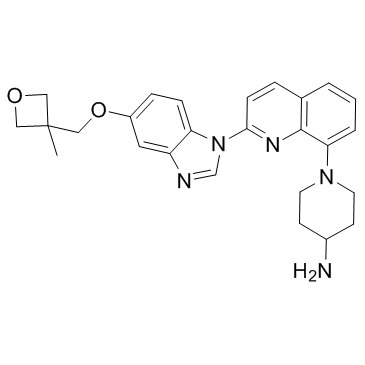670220-88-9
| Name | 1-[2-[5-[(3-methyloxetan-3-yl)methoxy]benzimidazol-1-yl]quinolin-8-yl]piperidin-4-amine |
|---|---|
| Synonyms |
1-{2-[5-(3-methyloxetan-3-ylmethoxy)benzoimidazol-1-yl]quinolin-8-yl}piperidin-4-ylamine
1-[2-[5-[(3-methyl-3-oxetanyl)methoxy]-1H-benzimidazol-1-yl]-8-quinolinyl]-4-piperidinamine ARO-002 Crenolanib 1-(2-{5-[(3-Methyl-3-oxetanyl)methoxy]-1H-benzimidazol-1-yl}-8-quinolinyl)-4-piperidinamine cc-84 4-Piperidinamine, 1-[2-[5-[(3-methyl-3-oxetanyl)methoxy]-1H-benzimidazol-1-yl]-8-quinolinyl]- 1-(2-{5-[(3-methyloxetan-3-yl)methoxy]-1H-benzimidazol-1-yl}quinolin-8-yl)piperidin-4-amine UNII-LQF7I567TQ CP 868596 CP868596 |
| Description | Crenolanib is a potent and selective inhibitor of wild-type and mutant isoforms of the class III receptor tyrosine kinases FLT3 and PDGFRα/β with Kds of 2.1 nM/3.2 nM, 0.74 nM, respectively. |
|---|---|
| Related Catalog | |
| Target |
PDGFRα:2.1 nM (Kd) PDGFRβ:3.2 nM (Kd) FLT3:0.74 nM (Kd) |
| In Vitro | Crenolanib has 25-fold more affinity for PDGFRA/B compared with KIT, and is approximately 135-fold more potent than imatinib for inhibiting the PDGFRA D842V mutation. The IC50 for crenolanib for a KIT exon 11 deletion mutant kinase is greater than 1,000 versus 8 nM for imatinib. Crenolanib has low nanomolar potency against the V561D + D842V-mutant kinase that is similar to its potency against the isolated D842V mutation. Both imatinib and crenolanib potently inhibit the kinase activity of the fusion oncogene with IC50 values of 1 and 21 nM, respectively, and inhibits PDGFRA activation in this cell line with IC50 values of 93 and 26 nM, respectively[1]. HL60/VCR and K562/ABCB1 cells, overexpressing ABCB1, are 6.9- and 3.6-fold resistant to crenolanib, respectively, in relation to parental HL60 and K562 cells. PSC-833 fully reverses resistance to crenolanib in both HL60/VCR and K562/ABCB1 cells. Crenolanib (1 nM-10 μM) stimulates ABCB1 ATPase activity in a concentration-dependent manner. Crenolanib treatment does not increase the cell surface expression of ABCB1. Crenolanib inhibits [125I]-IAAP photocrosslinking of ABCB1 at high concentrations, with 50 % inhibition at 10 μM, but has little effect at lower concentrations, below 1 μM[2]. Crenolanib decreases NSCLC cell viability, induces apoptosis in NSCLC cells, and inhibits cell migration in NSCLC cells[3]. |
| In Vivo | Crenolanib (10 mg/kg and 20 mg/kg) suppresses non-small-cell lung cancer tumor growth in vivo and induces tumor cell apoptosis, and the dosage of crenolanib applied is well tolerated by recipient mice[3]. |
| Cell Assay | Viable cell numbers following drug treatment are measured using the WST-1 assay. Briefly, 1×103 cells are seeded in 100 μL complete medium per well in 96-well tissue culture plates and incubated with crenolanib (0-10 μM) at 37°C in 5% CO2 for 96 h. 10 μL WST-1 reagent is then added to each well, incubation is continued for two additional hours and the color developed is quantified according to the manufacturer’s instructions. Each experiment is performed in triplicate. IC50 concentrations are calculated by the least square fit of dose–response inhibition in a non-linear regression model using GraphPad Prism V software. |
| Animal Admin | A549 cells are injected into the axillary regions of mice (2×106 cells/mouse). When the tumor volumes reached 70 mm3, the mice are randomLy allocated to the control group, low-dose crenolanib group (10 mg/kg), or high-dose crenolanib group (20 mg/kg) (n=6 per group). The vehicle for crenolanib treatment consists of 10% 1-methyl-2-pyrrolidinone and 90% polyethylene glycol 300. The tumor size and mouse body weight are measured every other day for about 2 weeks. The tumor volume is calculated as follows: (mm3)=(width×width×length)/2. After treatment, the mice are euthanized using carbon dioxide, and the tumors are harvested and analyzed. |
| References |
| Density | 1.4±0.1 g/cm3 |
|---|---|
| Boiling Point | 676.6±65.0 °C at 760 mmHg |
| Molecular Formula | C26H29N5O2 |
| Molecular Weight | 443.541 |
| Flash Point | 363.0±34.3 °C |
| Exact Mass | 443.232117 |
| PSA | 78.43000 |
| LogP | 2.99 |
| Vapour Pressure | 0.0±2.1 mmHg at 25°C |
| Index of Refraction | 1.704 |
| Storage condition | -20℃ |
| Precursor 0 | |
|---|---|
| DownStream 1 | |

